Before Roger Penske Was a Billionaire, He Was a Very Successful Amateur Racer
Before the dealers, the truck rentals, and the team ownership that saw him set records at the Indy 500, Roger Penske was a hugely successful driver.

From the May 1962 issue of Road & Track
HE TURNED TURNED UP at the Drivers School at Marlboro, Md., in the early spring of 1958. The name on his brand new SCCA membership card was Roger Penske. A tall, dark-haired, intense young man, he chose to take his instruction in a hot fuel-injected Corvette.
Penske drew as his instructors Dick Thompson, Bark Henry and Fred Windridge. "He was a good driver," Thompson said recently, "but the only other thing I remember about him is that he came to the school with fabric brakes on the Corvette and I got him to switch to the metal type." Despite this lack of a lasting impression, Penske and Bob Davis, now a top mechanic, graduated from the school with the two competition licenses given out at that session.
Three weeks later Penske returned to Marlboro for the National races and, in the fourth event of the day, proceeded to put his schooling to good use. For 13 laps of the 20-lap event he tailed the leading Windridge-driven Corvette, only to be forced into the pits with over-heating.
That was four years ago. Today Penske needs no introduction to those who follow sports car racing in America—his ability is a matter of record. In 1961 he captured his second SCCA National Point Championship in a row. And, facing Europe's best in three of the North American Racing Season events, he consistently placed ahead of his amateur compatriots, with the exception of Jim Hall at the Riverside race. Closing the season at Nassau, he came in second behind Dan Gurney and won additional honors for being named "U.S. National Champion" by Competition Press.

In four short years, then, Penske has risen from virtual obscurity to national prominence in the tight little competitive world of racing. At 25 that isn't easy—especially when you have also gotten married, finished college and are holding down a responsible job in industry. How did Penske do it? It began something like this:
Roger S. Penske was born in Shaker Heights, Ohio, Cleveland's answer to Beverly Hills or Westchester. In junior high he had a motor bike, which was soon displaced by a 500-cc Norton motorcycle when he reached high school. After several street TTs, he and the motorcycle parted company rather abruptly—on the way to school one day, at an undisclosed rate of speed, he met a car. This left him with some broken ribs, a fractured leg, a slight concussion, and minus a motorcycle.
But fate being what it is, the accident led to a part-time job in a garage and an enviable succession of used cars. "Let's see, first was the TD, then a couple of American cars, and some drag racing. Next was another MG, this time a TC which I ran in a hill climb—I was beaten, badly! Then I rebuilt and souped up a 120 Jaguar. I got my first trophy with it in a field trial. Then I joined the Ohio Valley Sports Car Club and the Left Turn Club. That was racing on dirt track ovals, which was not only fun but a good way to get a lot of experience fast."
By now Penske had moved up to a XK-120-M and was well on his way through Lehigh University. It was here that he met Ben Moore, who ultimately convinced him that the 1957 Corvette should be his next car. Immediately after his twenty first birthday he joined the SCCA, and the Marlboro Drivers School soon followed.

Penske, his wife Lissa, and their young son Roger, Jr., now live in the small town of Gladwyne, Pa., which is located slightly northwest of Philadelphia. In his den, Penske and I spent a winter's afternoon discussing his attitude toward racing.
"Why did I start with a Corvette? Well, the way I look at it, if you want to learn how to drive fast, start with a fast car. I think it's rather pointless to start with an MG, move up to a Healey, then a Jag, say. If you intend to drive fast cars don't start with a slow one! It's a good way to pick up bad habits. But, actually, I drove only a couple of races with the Corvette before I sold it."
Four months after he took his schooling at Marlboro, he not only sold the Corvette but, briefly, retired to finish college, get married and get a job. He couldn't make the retirement stick and after 3 months was ready to have at it again.
When an opportunity came to buy Bob Holbert's Porsche RS he snapped it up and then reappeared at Malboro. The event was a local affair, or about as local as any event at the popular circuit can be, but in it Penske again faced most of the competition he had started with some seven months before. In particular, he found ex-teacher Fred Windridge, who was now ensconced in a black Lister-Corvette. In two events Windridge's superior horsepower enabled him to beat Penske to the flag, but in both races his only real competition came from the little Porsche with its novice driver. Roger had really come out of "retirement."
With the RS Porsche (and, later in the season, an RSK bought from Bernie Viehl) the 1959 season was a fair-to-middlin' year for Penske. In eight races he managed to place no lower than 4th (with one DNF at Cumberland) and finished the season 3rd in the F-Modified Point Championships behind Don Sesslar and Bob Holbert.
Penske's third year started with a bang at Pensacola, Fla., in January, where, after a tight race with Gus Andrey's Tipo 61 Maserati, he managed to bring the RSK in 2nd overall. With this as a starter, the rest of the 16-race season dropped like a big plum into his pocket. By the middle of June he had the F-Mod class sewed up and was well on his way to his first championship. However, few of the season's highlights stand out in his memory with as much satisfaction as his return to Marlboro, where he ran away with the President's Cup. This was just two years after his first race there. Then there was the little-noted race at Daytona in June, which in another way was even more spectacular. Penske entered four races (in what may or may not have been an RS-60) and astounded the entire assemblage by taking all four events with ease. And this was after losing his clutch during practice, which forced him to start well back in the pack in several of the races. Then, of course, there was Nassau, where he took a first, a 4th and a 5th against some of the toughest competition in the world.

Penske's third season ended with him not only taking his own F-Modified Class but also taking 2nd in E-Modified be hind Bob Holbert. The 2nd place was due to his buying Jim Hall's RS-60 later on in the season, and several races in which he was "bumped" up to the next higher class because of a lack of entries. He also received The New York Times Driver's Award that year.
In January of 1961, Penske sold the RS-60 Porsche and took delivery from Modena of a Tipo 61 Maserati. It was in this season that Penske came of age as a driver and became recognized as a definite threat in any race that he entered. His biggest adversary was Walt Hansgen who, despite a late start due to European commitments, came closest to taking the D-Modified crown away from him. In fact, the record shows that just about all of Penske's 2nd-place finishes were because of Hansgen. But there was also the expatriate American, Peter Ryan, who threatened Penske's chances several times.
The season started with Sebring, where he and Holbert drove a superb race to finish 5th over-all (ahead of the entire Porsche team) in the lowest-displacement Porsche entered. Right after Sebring he entered the Maserati (now rechristened the Telar Special) at Vineland and took his first over-all win. Skipping the first National at Marlboro, he appeared at the VIR, only to have Hansgen beat him to the flag. Then at Cumberland, with a beautiful lead and a new lap record, he blew a piston and the race. He then took the next three races in a row, at Elkhart Lake, Lime Rock and Meadowdale. In these latter two events it was Ryan who gave him the most trouble. Ryan turned up at Lime Rock with a Lotus XIX, and the race was so fast and close that Penske invited him to share the winning lap at the end of the event. At Meadowdale Ryan drove one of the noisy and potent Comstock-Sadlers, and proceeded to push and pass Penske unmercifully. Despite a bit of metal-to-metal contact between them in one corner and several slow laps under a yellow flag, this precocious duo put on a show that the fast Meadowdale circuit will find hard to duplicate.
At Bridgehampton in August, Hansgen again beat Penske, but only after a vicious nose-to-tail, lead-changing battle. Later that month, he sold the Maserati and took delivery of one of the three Cooper Monacos in the world, and it at first appeared that this new "Telar Special" would cost him his championship. In its first race, at Indianapolis, he was leading Hansgen and going like a frightened bat when the magneto sickened, forcing him again into 2nd place. Then at the Glen in September, with a 41-sec lead, his clutch shaft bearing let go and he chalked up another DNF— he considers this loss the most irksome of his career. When the SCCA season ended, though, he had managed to squeeze out a total of 60 points, against Hansgen's 58, to take the D-Modified Point Championship and the rather ambiguous SCCA title of The Most Improved Driver of the Year.
With delivery of an F-l Cooper, he then went on to take an 8th place at the Glen Grand Prix, the second American driver under the flag (after Gurney); 4th at Riverside, behind Hall and Gurney; a 5th at Laguna Seca, with Gurney 2nd; and a 2nd in the big Nassau Tourist Trophy race, behind Dan Gurney again.
Seated across from me, silhouetted against a window, Roger Penske did not look much older than the first time I had seen him drive at Marlboro. Yet, around his eyes and in his speech were the signs of maturity and experience. He is now, of course, a family man and has a position as Industrial Sales Engineer with Alcoa Aluminum. Yet I got the feeling that his age, or perhaps his youthful appearance, is something of a private source of irritation. Its basis seems to be the feeling, at times justified, that people are not taking his racing as seriously as he does, that they feel he has come up too fast and that his successes are flukes. "I think it was up at Bridgehampton that some guy came up to Walt Hansgen after the race and said, 'That was quite sporting of you to let that kid Penske dice with you during the race, Walt.' And I'd spent the better part of the race either leading Walt or right on his tail! I gave Walt a hard time and this guy thought he was doing me a favor!" This type of unintentional criticism is fairly com m on, of course, and is something any successful driver has to expect and accept.

Like most top drivers today, Penske is a natural athlete with a high degree of balance and timing. (He is also a proficient water and snow skier, and shoots golf in the 80s.) "I developed my own style of driving" (although it has been noted that he resembles Dick Thompson in timing and brio) "and all I want is to drive smoothly and fast. Despite stories to the contrary, in 1960 I think I spun out only twice; wasn't it only twice, Lissa?" he asked, turning to Mrs. Penske. With a wry smile she agreed and named the events, each spin obviously sharp in her memory. "And I think I've had comparatively few mechanical troubles, but this is due to Roy Gane, who prepares all my cars—he maintained Elliott Pew's AC Bristol and Eve Mull's cars at one time, remember?"
We then got on the subject of the cars he had owned and driven, and his opinions of them. "Ben Moore got me to buy the Corvette and, as I mentioned, I think that was a good car for me to start with. Then there were the Porsches, the RS, the RSK, and the RS-60— I think the RSK taught me the most. I only kept the RS-60 for a couple of months before I bought the Tipo 61 Maserati." The Maserati brought to mind an opinion I had heard early in 1961 to the effect that, while Penske was a hot Porsche driver, he'd gone over his head in buying the bigger, more powerful Maserati. Penske's disgust was apparent, "Ah, that's silly! Anyone who has driven both cars knows that the Maserati is an easier car to drive. The Maser was terrific–it was more fun than any car I'd ever owned. It had all the power you could use, and had marvelous handling and brakes. I was sorry to get rid of it, but it was too heavy compared with the rear-engined jobs. Now the Monaco is an entirely different sports car. Actually, it's an F-1 car with a sports body. It's quite a bit like the Porsche, except that it handles much better. It can get quite violent though, and when it breaks loose, it's gone!
"Formula 1 racing, now, is something else again. I've got a good car but in F-1 it is harder to reach the top, mainly because it is more exacting, almost an art in itself. I like sports cars, but I think there is some good racing coming in F-1. Unfortunately, I don't think that it is too much of a crowd pleaser, probably due to the lack of spectator identification with the car. As far as U.S. participation is concerned, I think we can drive with the best from Europe. We proved that at Laguna Seca. Personally, I think I could have done better than 5th at Laguna Seca."

Since his last three cars (the Maserati, the Cooper Monaco, and the F-1 Cooper) were bought outright from the factory, I boldly asked him just where all his money came from and what kind of budget he raced on.
"Actually, the money comes from two sources. I'm fortunate enough to have as a friend John M. Wyatt III, of Richmond (VA.) who not only acts as sort of business manager, but also helps finance some of my racing expenses. Also, in 1960, just before I bought the Maserati I went to the duPont Company in Wilmington and presented the idea of using the car as part of the advertising for the new duPont radiator coolant, Telar. My idea was that I would use Telar exclusively in the car and enter it in races as the Telar Special. In return, this could be used in duPont advertising to get exposure in racing and trade magazines. The company bought the idea.
"My expenses over a year's time amount to well over $10,000, not including car purchases. Now here," as he brought out a sheaf of papers with neatly totaled columns, "is how my expenses run. All the money I get is turned over to John Wyatt, who takes care of all the book work and pays all the expenses. I don't see any of the money." In view of the foregoing, I asked whether he considered racing a business or if he might go into it on this basis in the future. Penske's answer to both questions was an emphatic, "No."
This sort of arrangement, although not specifically banned, is seldom encountered on the amateur sports car circuits. While 1962 and the coming years will undoubtedly see it become more prevalent, it is interesting to note, in this case, the timing involved. Penske entered into his contract with duPont after only his third year of racing, and actually only after his first year of note. It says much for Penske's ability as a salesman.

I then asked what he would advise for, say, a medium-income enthusiast who wanted to try his luck. "First off, of course, to get an SCCA license he will have to graduate from an accredited driver school— this I heartily recommend. But he has to remember that racing is an expensive sport, particularly if he is serious about it and is aiming for something like the National Championships. As a rule of thumb, he might figure something like this: say $3000 for his car, then about half of this amount again as expenses over a year if he is going to most of the National races. Today, with the Formula Intercontinental and the pro racing circuit money available, I think he can have a pretty good chance."
In 1962 Penske will race in the major SCCA Nationals, the large American and Canadian pro races, with the Briggs Cunningham équipe at Sebring and, for the first time, in Europe. As for further racing in Europe, Penske states,"I've considered it, and I've had some bids, but right now I don't think so–I have only a certain number of days off a year from Alcoa for my vacation. Actually, my idea of a European season would be to go over with my own car as part of an American racing team. With something like three cars and three drivers, and maybe American equipment–the new aluminum engines show quite a bit of promise–it is quite feasible. As I see it, we might be able to get, say, an oil company as a sponsor." If the past is any criterion, I, at least feel that if Penske really put his mind to it, he could probably sell the AMA the idea of sponsoring a race team!
At 25, with European racing well in the future, if at all, Penske is one of the youngest and most promising of the elite corps of American drivers. In a period when most of the top U.S. drivers are in their thirties and forties, his age, ability, and uncommon business sense may, in a few years, see him fall heir to the racing crown of the U.S.

.css-1693l19{margin-right:0.25rem;margin-top:0.2rem;width:1.125rem;background-repeat:no-repeat;-webkit-background-position:center center;background-position:center center;}.loaded .css-1693l19{background-image:url('/_assets/design-tokens/roadandtrack/static/images/slash.svg');} Watch Next

.css-ryud0:before{margin-right:0.3125rem;width:1.125rem;height:1.125rem;content:'';display:inline-block;-webkit-background-size:1.125rem;background-size:1.125rem;background-repeat:no-repeat;-webkit-background-position:bottom;background-position:bottom;}.loaded .css-ryud0:before{background-image:url(/_assets/design-tokens/roadandtrack/static/images/slash.3b27b9a.svg);} Motorsports
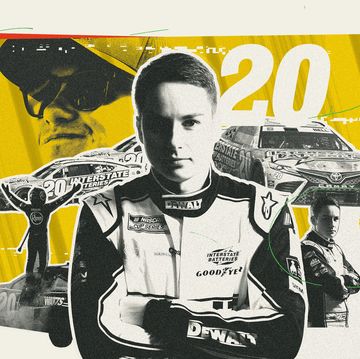
Ryan Blaney’s NASCAR Struggle Could End in a Title

Rejoice in the Dusty Chaos of Drag Racing on Dirt
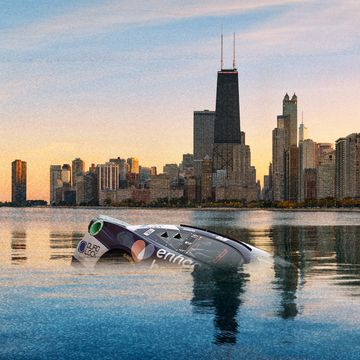
NASCAR Needed Chicago to be a Success

Button Enjoyed Out-Dragging LMP2 Cars at Le Mans
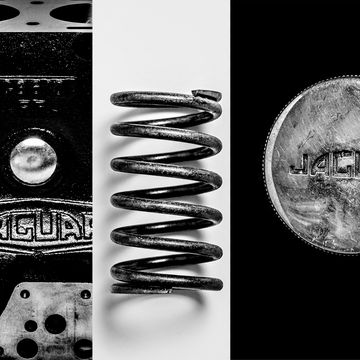
Deconstructing the Engine That Dominated Le Mans
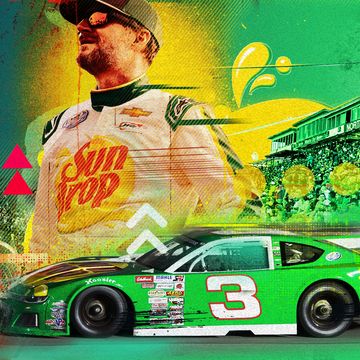
NASCAR’s Most Iconic Ghost Track Is Back
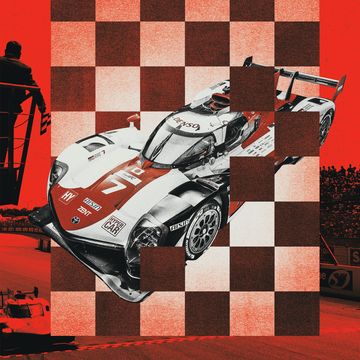
What's Wrong With Toyota Winning Le Mans?
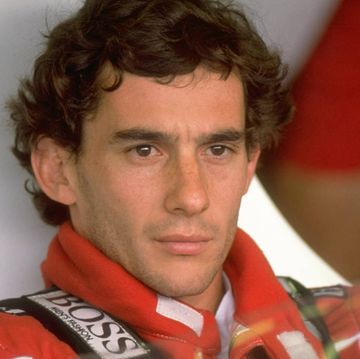
Happy Birthday, Ayrton Senna
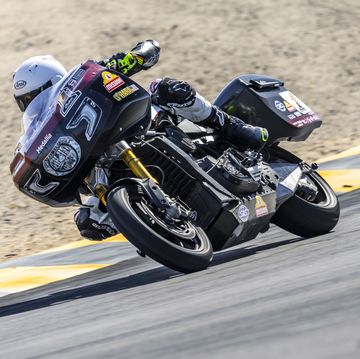
Ridin’ Loose With The Bagger King
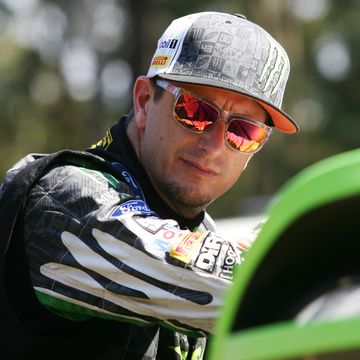
American Rally Association Retires Number 43
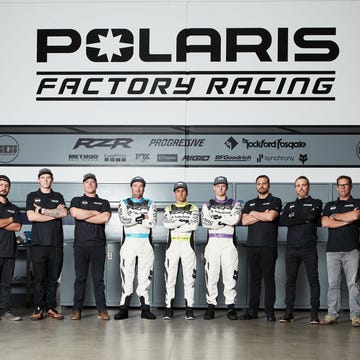
Polaris Side-by-Sides Are Going Factory Racing

Roger S. Penske
Inducted 2015, industry leader of the year award 1994.
Roger Penske’s international automotive and transportation enterprise reported sales of $19 billion in 2014, employing 39,000 employees worldwide. Holdings include the world’s second largest automobile dealership group as well as truck and equipment rentals, leasing and logistics services.
But for all of those accomplishments, the Corporation’s best-known asset is Penske Racing. With an unrivaled record for wins at the Indianapolis 500 and dominant presence in virtually every major national series, Team Penske is the most respected “brand” in American motorsports. Roger’s path to success began as a car-loving teenager in suburban Cleveland, Ohio. From his parents’ driveway Penske would buy and sell sports cars, which he had purchased and restored. Some found their way to the track — and Victory Circle, with Roger at the wheel. By 1961 Penske was honored as Sports Illustrated’s “Driver of the Year”.
In 1965, at the top of his game, he gave up driving to build his automotive empire, starting with a dealership in Philadelphia, then acquiring a truck leasing business, a second dealership and two racing tire distributorships. In 1969, Penske Corporation was formed. While his passion for driving may have been put on hold, his love of motorsports never waned. Joining forces with driver/engineer Mark Donohue, Penske Racing was created, becoming the motorsports arm of Penske Corporation. Penske Racing debuted at the Indianapolis 500 in 1969, winning the first of 16 Indy 500’s in 1972. Since then, Penske Racing has dominated in virtually every form of racing, earning nearly 400 victories and 27 National Championships including IndyCar, Sports Car, Trans Am and NASCAR.
The reasons for Penske’s remarkable success were well documented in the late Mark Donahue’s book, “The Unfair Advantage”. Their “unfair advantage” was identified as a total dedication to preparation and professionalism. Those same qualities are found in all Penske enterprises, on the track or in a boardroom. Clearly, racing improves the product.
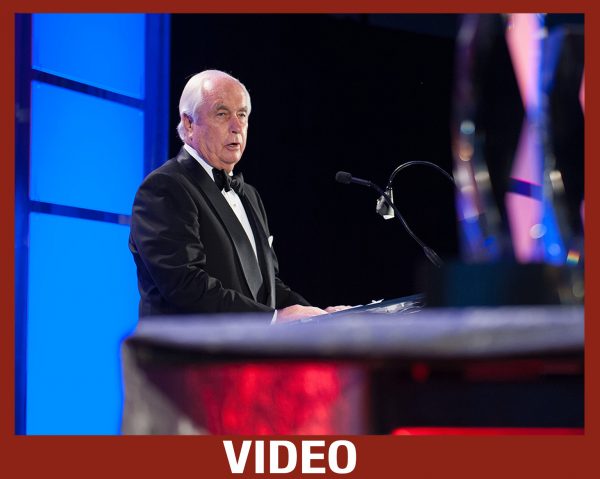
2015 Automotive Hall of Fame Induction acceptance speech.
2015 Automotive Hall of Fame Induction Tribute Video.
2015 Inductees Ratan Tata, Luca di Montezemolo, Roger Penske.
Roger Penske at the 2015 Automotive Hall of Fame Induction and Awards Ceremony.
- Penske Racing Team: 40 Years of Excellence
further reading
- Roger Penske keeps his foot on the gas after 50 years in racing
- The Penske Racing Museum
Class of 2015

Luca Di Montezemolo
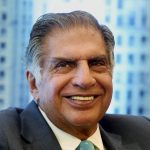
Ratan N. Tata
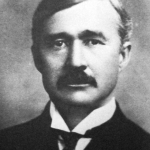
Elwood Haynes
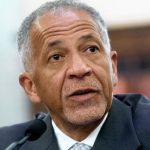
Rodney O’Neal
Inductees from related companies, penske corporation, motorsports, dealerships, sign up for our mailing list.
Roger Penske: The Penske Way leads to another year of excellence

As Roger Penske explained how he completed the blockbuster purchase of Indianapolis Motor Speedway and the IndyCar Series , a deal negotiated and finalized under a cloak of secrecy, his thoughts turned to the man he credits with putting him in this position.
Penske’s love affair with IMS began in 1951 when his father, Jay, first took him to the track as a 14-year-old. From there Penske’s passion for motorsports was spurred, a passion that would propel him to become one of the most successful team owners in racing history. And in each step of his career, be it as a team owner or a businessman whose company generates revenues in the billions, Penske was guided by his dad’s steadfast belief that “effort equals results,” something that’s long been an ethos of Penske, the Penske Corporation and Team Penske.
Advertisement
“What it really says, that in the United States of America, if you work hard and you’re committed and you have a great group of people, you get great success,” Penske said Nov. 4 at the introductory news conference. “So today I hope my dad’s looking down at me and looking at this group and saying, ‘Son, you did a good job.’”
Following the standard he sets, Team Penske enjoyed an unprecedented year of motorsports success around the globe:
- In IndyCar, Simon Pagenaud earned Penske’s 18th Indianapolis 500 victory, Josef Newgarden captured the organization’s 15th IndyCar Series championship, and Pagenaud, Newgarden and Will Power combined to win nine of 17 IndyCar races.
- Scott McLaughlin won the Australian Supercars championship, the prestigious Bathurst 1000 (along with co-driver Alexandre Premat) and the two-car operation won 20 of 32 races.
- In NASCAR, Ryan Blaney, Brad Keselowski and Joey Logano combined for six Cup wins, with Blaney and Logano advancing to the Round of 8.
- Dane Cameron and Juan Pablo Montoya won the top-flight Daytona Prototype Class championship in the IMSA WeatherTech SportsCar Championship, on the strength of seven consecutive podium finishes and wins at Mid-Ohio, Detroit and Laguna Seca.
“You can’t deny that Team Penske is the benchmark,” Newgarden said. “They are the team that everyone targets. I always make the comparison that driving for Team Penske, it’s like playing for the (New York) Yankees. You’re basically competing with a dynasty here, and they’re the best to have done it and they’re the group that everyone wants to be and the group everyone wants to beat.”
For his leadership on and off the track, he has been selected as The Athletic’s 2019 Motorsports Person of the Year.
Meticulousness is a trademark for the 82-year-old Penske. It is why his cars are customarily faster than the competition. It is why his cars are reliable and rarely suffer mechanical failures. It is why for six decades, Team Penske, be it in IndyCar, NASCAR or sports cars, is the organization against whom every other outfit measures itself.
“If you walk in the workshop after everyone’s left, there’s nothing left on a bench. Everything is absolutely spotless,” said Power, who won the 2018 Indy 500 and the IndyCar championship in 2014. “It’s just the process, even the small things that matter and just has everyone in that mindset that all the small details matter. And that just goes for everything, not just on the race cabinet, in the workshop, the race trucks, the appearance of everything has to be perfect. That just filters through everything as far as assembling gearboxes, engines, assembling the whole car, doing the car setup as far as wheel alignment.
“He has a lot of attention to detail. Those things really matter to him, you could say he’s a perfectionist.”
That includes the trademark dress code for drivers: black slacks and button-up shirts.
“It’s important to look good when we represent a brand and I think it explains itself without having to be heard,” Pagenaud said. “We represent a big brand. It’s not just the race team, it’s an empire that Roger built. So it’s a bit like when you work at Nike, you represent Nike or Puma. We represent a brand that’s called Penske and it’s still growing so it’s very important to be detailed oriented.”

Ask a member of Team Penske why the organization is able to accomplish what other organizations do not, and the answer is universal: Because of the expectation set by the man in charge. Nothing is overlooked, every conceivable scenario is considered and people are empowered to feel they are a critical facet of the group’s success. It is why he carries around a notebook and pen, so when he notices that something needs addressing, he won’t forget. It’s a common sight for those under the Team Penske banner to see the boss jotting notes down when something catches his attention.
“When I see Roger at the shop, it is incredible because he can see every little detail like he lives in the house 24/7,” Pagenaud said. “He makes notes. He has this little piece of paper, he makes notes and he acts very quickly when he wants something done. It’s very impressive, it’s very clean everywhere. It’s the Penske way and you can only admire it because it takes dedication and discipline and that’s what the Penske way is like.
“As a leader, the thing that impresses me the most is the fact that he remembers everybody’s name. He’s got 65,000 employees and he walks up to you and shakes your hand and knows your name and what’s going on in your family. He is very close to people and he always talks about human capital. What impresses me the most is how he’s able to get the best out of people by finding their qualities and knowing what they are; it is just phenomenal the way that he interacts with his people.”
Pagenaud grew up in Montmorillon, France, the son of a father who owned a supermarket, and as he worked in the store as a kid stocking shelves and performing other duties he spent time observing his father. Like Penske, Pagenaud’s father carried a notebook, and Pagenaud sees a lot of similarities between how his father ran his business and how Penske manages his vast global empire.
“They’re very common, a lot of common traits,” Pagenaud said. “So when I see the notebook I know exactly what’s going on, and I found it funny, but it’s another example of discipline. Instead of trying to memorize it and then forget it, it’s about writing it down and giving it priority. So it’s pretty cool to see how such a powerful man does business and it definitely gives you a good example of how you should be like.”
Penske’s notebook was out when he took a firsthand tour of IMS on Nov. 5, the day after it was announced that Penske Entertainment Corp., a subsidiary of Penske Corporation, would purchase the iconic track.
“I always like to work from a top 10 (list) and see the things that we can do to make it fan-friendly, certainly from a competitive perspective,” Penske said.
A transaction of this magnitude typically invites scrutiny and raises myriad questions about what might happen going forward. In this instance, the news was met with near-universal acclaim across the motorsports spectrum. The consensus was there was no better successor than Penske, whose business proficiency combined with his racing knowledge and adoration for the Indianapolis 500 meant the iconic speedway was in great hands.
It speaks to Penske’s sterling reputation Penske that a potential conflict of interest — an IndyCar team owner buying the series in which he competes — was a non-issue among fellow owners. (He will no longer continue as the race strategist for Will Power.) Instead, the move was heralded for the opportunities it presents for IndyCar to grow.
“The greatest news ever for IndyCar racing, maybe for racing,” rival team owner Chip Ganassi said. “Roger is a mogul in the automotive industry and (IMS) is arguably the birthplace for a lot of automotive technology — there is isn’t a better guy to sell it to.”
That’s why the Hulman-George family, which had owned the track since 1945, decided to approach Penske and gauge his interest in becoming just the fourth owner of IMS in its 110-year history.
On behalf of his family, Tony George initially broached the subject in a somewhat unusual setting: on the grid prior to the Sept. 22 IndyCar season finale at WeatherTech Raceway Laguna Seca, just as his driver, Newgarden, was looking to clinch the championship. Yet George had Penske’s attention.
After the race and the celebration for Newgarden’s title win, Penske demonstrated the acumen that has impelled the Penske Corporation to revenues exceeding $32 billion by following up with George by email that evening, then another email the next day. The deal, which industry sources say is between $250-$300 million, was completed roughly six weeks later and is expected to be finalized in January.

It is a monumental transaction with far-reaching implications not just for IndyCar, but NASCAR, IMSA, USAC and potentially even Formula One. Penske stated he’d like to see F1 return to IMS after a contentious breakup following a tire debacle in 2005 that turned off a large chunk of fan support and doomed the race at IMS after 2007. (How many of you remember that Penske’s PC4 won the Austrian Grand Prix in 1976 — the last time an American constructor triumphed on the primarily European-based series?)
Fittingly, amid a year of Team Penske dominance on the track, Penske also won big in the boardroom. That is the essence of Penske; a captain of industry, recognized as “The Captain” in racing circles.
The multitude of accolades — which included induction into the NASCAR Hall of Fame in February — culminated Oct. 24 in a ceremony at the White House. In the Oval Office, President Donald Trump presented Penske with the Presidential Medal of Freedom, the nation’s highest civilian honor.
“You’re a very unique person and truly a great champion and truly a winner,” Trump said. “No matter what you do, it turns to gold. You are a legend in the speedway and you’re a legend in business, and your name is revered everywhere the checkered flag flies and beyond that.
“He’s built a team and a legacy that will endure forever. I mean, frankly … nobody will ever be able to challenge this. I don’t care what they do, how good they are, there are some things you can’t do. And it will ensure forever in the history of racing and in the history of sports.”
As Penske’s father explained to him decades ago, success is predicated on your effort and commitment to performing the best job possible, a maxim that has never been achieved so successfully within Team Penske than over the past year and embraced by those within the organization.
“Roger doesn’t do anything if he can’t do it 100 percent and the race team has the exact same mentality,” Pagenaud said. “They work constantly. There’s very little vacation. It’s a very nice environment to work in but you always have to give your best.”
(Top photo: Chris Graythen / Getty Images)
Get all-access to exclusive stories.
Subscribe to The Athletic for in-depth coverage of your favorite players, teams, leagues and clubs. Try a week on us.

Jordan Bianchi is a motorsports reporter for The Athletic. He is a veteran sports reporter, having covered the NBA, NFL, Major League Baseball, college basketball, college football, NASCAR, IndyCar and sports business for several outlets. Follow Jordan on Twitter @ jordan_bianchi
Museum Closed for Renovations – Track Tours Still Available | LEARN MORE
Roger Penske
ROGER PENSKE is by far the most successful owner/ entrant in the history of the Indianapolis 500 with 18 victories through 2021, thus more than tripling Lou Moore’s record of five established from 1938 through 1949. Following his first win in 1972 with Mark Donohue, Penske won four times with Rick Mears (1979, 1984, 1988, and 1991), three times with Helio Castroneves (2001, 2002, and 2009), and once each with Bobby Unser (1981), Danny Sullivan (1985), Al Unser (1987), Emerson Fittipaldi (1993), Al Unser, Jr., (1994), Gil DeFerran (2003), Sam Hornish, Jr. (2006), Juan Pablo Montoya (2015), Will Power (2018), and Simon Pagenaud (2019). A successful sports car driver, Penske won the 1962 L.A. Times Grand Prix at Riverside and finished the year as the United States Auto Club Road Racing champion. After competing in the United States Grand Prix at Watkins Glen, New York, in 1961 and 1962 and winning all three Nassau Trophy races in the Bahamas in 1964, Penske retired from driving to pursue business interests. The scope of successes by Team Penske since the mid-1960s includes race wins and championships (28 total through August 2015) in such diversified racing disciplines as United States Auto Club and Championship Auto Racing Team National Championship racing, Sports Car Club of America’s Can-Am series, Trans-Am, NASCAR (National Association for Stock Car Auto Racing), and long-distance endurance races, typically competing for several different championships at the same time. Penske entries have won such marquee races as the 24-Hours of Daytona, 12-Hours of Sebring, and the Daytona 500, as well as the 1976 Grand Prix of Austria with Irishman John Watson during a brief run in Formula One racing.
YEAR INDUCTED: 2002
--> image gallery -->.
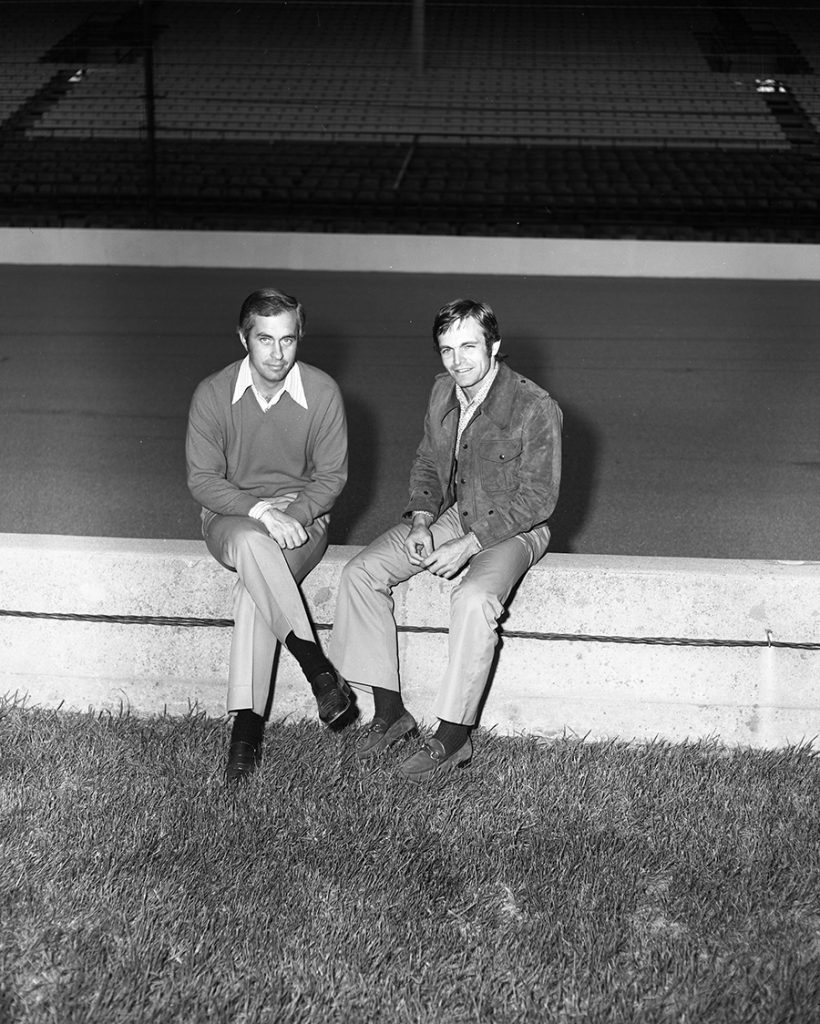

- Spark Program
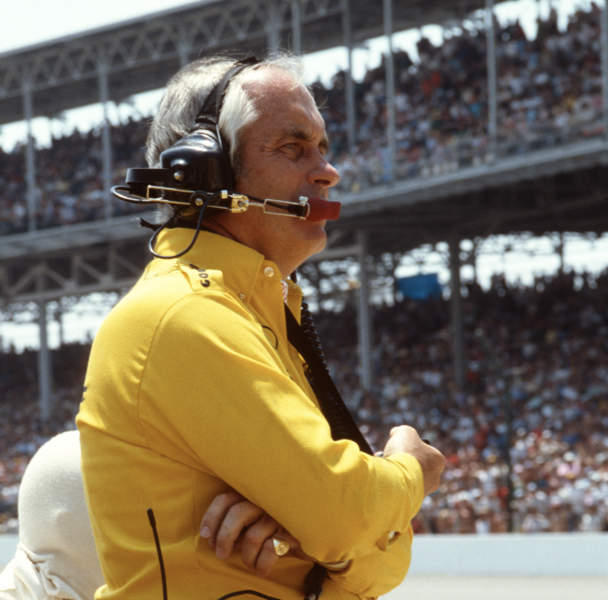
By Preston Lerner
Racing, so the saying goes, is a great way to turn a big fortune into a small one. Unless, that is, you're Roger Penske, a man who's made a career out of standing convention on its ear. Penske was only 27 years old, seemingly at the height of his powers, when he hung up his driving suit to concentrate on the business of business. Today, he commands a vast corporate empire that embraces more than 13,000 employees. More to the point, he remains the captain of Penske Racing, perhaps the most dominant race team in American history.
Behind the wheel, Penske was talented enough to be honored as the Sports Car Driver of the Year by Sports Illustrated, The New York Times and the LosAngeles Times. But even then, he aspired to be more than the next Fangio. "I don't want to be known as a race driver," he told a reporter a year before he retired and he isn't. Today, Penske is remembered best as the man whose cars have won ten Indy 500s; two Can-Am championships; three Trans-Am titles; numerous Winston Cup races; and one of only three Formula I Grands Prix won by an American team. Hes also a founding director of CART, a principal of Ilmor Engineering, the owner of two major racetracks and a constructor in his own right.
Few men have cast as large a shadow over their respective fields as Penske. Even as a privateer, he always insisted that his cars look impeccable. And nobody ever earned the Unfair Advantage as often as he did, whether it be by turning a Formula I wreck into a world-beating sports car, building special refueling rigs for lighting-fast Trans-Am pit stops, introducing turbocharging to the Can-Am series, or developing an entirely new engine to win a single race the 1994 Indy 500.
Born in Shaker Heights, Ohio, in 1937, the son of a corporate executive, Penske started racing sports cars before graduating from Lehigh University. He won numerous races and several SCCA championships while driving a wide variety of machinery, Jags, Porsches, Coopers, Maseratis, Ferraris, Corvette Grand Sports and Chaparrals. But it was with a mongrel known as the Zerex Special that Penske achieved his greatest notoriety.
A wrecked Formula I car transformed into a two-seat sports racer, the Zerex Special met the letter if not the spirit of the law. With it, Penske blitzed the fields at Riverside and Laguna Seca to win the country's premier sports car races of 1962. Coupled with two more victories in Puerto Rico and Nassau, Penske pocketed $34,350 a princely sum by the standards of the day. At the same time, he also pointed the way toward a new era of major-league corporate sponsorship.
In 1964, Penske retired from driving after scoring back-to-back wins in Nassau in a Grand Sport and a Chaparral. Two years later, he returned to racing as an entrant. Although the team's debut at Sebring in 1966 with al obsolete Grand Sport was inauspicious, Penske soon bought a Lola T70 and hired Mark Donohue as his fulltime driver.
In Donohue, the Brown University engineering graduate, Penske found the perfect foil. Usually racing in irreproachable Sunoco livery, the two men dominated Trans-Am (in Camaros and later Javelins) and Can-Am (in the Porsche 917-10 and 917-30 Turbopanzers) racing so comprehensively that neither series was ever the same again. At the 24 Hours of Daytona in 1969, they scored Lola's first long-distance victory. Turning next to Indy cars, they won the 1972 edition of the 500.
In 1974, with little left to conquer here in the States, Penske created Penske Cars Ltd. in Poole, England, and went Grand Prix racing. The Formula I adventure was an unhappy one, reaching its low ebb when Donohue was killed in a practice crash in 1975. Although John Watson gave the PC4 a historic victory in the Austrian Grand Prix in 1976, Penske shut down his Fl operation at the end of the season and concentrated his efforts on Indy cars.
Since then, nobody has done it better. With a stable of champions that includes Rick Mears (a Penske discovery), Emerson Fittipaldi, Mario Andrctti, Tom Sneva, Danny Sullivan, Paul Tracy (another Penske find) and Bobby, Al and Al Unser Jr., Penske Racing posted 91 wins, 114 poles and nine CART championships through the end of the 1994 season. Meanwhile, Rusty Wallace scored another 18 Winston Cup victories in Penske Racing South cars. And now, of course, Roger Penske is being inducted into the Motorsports Hall of Fame.
Keith Black
Louis Chevrolet
Peter De Paolo
Chip Hanauer
Bruce McLaren
Fireball Roberts
Juan Pablo Montoya
Robert E. Petersen
Frank "Scoop" Vessels
Earl Baltes
Peter Manso
Frank Kurtis
Ivan "Ironman" Stewart
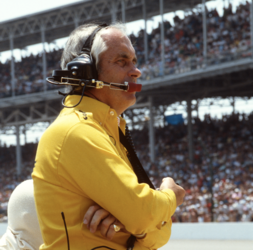

- 2024 Overview
- Roger Penske
- Team History
- Penske Pals
- Driver Cards
- Team Penske Hall of Fame
- Year-By-Year Highlights
- Team Penske Facility
- Penske Racing Museum
- Team Penske Online
- Team Penske Retail Store
- NASCAR Cup Series
- NTT IndyCar Series
- IMSA WeatherTech SportsCar Championship
- FIA World Endurance Championship
- Penske Material
- Joey Logano
- Ryan Blaney
- Austin Cindric
- Josef Newgarden
- Scott McLaughlin
- Mathieu Jaminet
- Dane Cameron
- Felipe Nasr
- Matt Campbell
- Michael Christensen
- Frederic Makowiecki
- Kevin Estre
- Andre Lotterer
- Laurens Vanthoor
- Driver Appearance Calendar
Team Penske
- About Team Penske
Penske Racing - Roger Penske
Roger Penske is the founder and chairman of Penske Corporation, a closely-held, diversified, on-highway, transportation services company whose subsidiaries operate in a variety of industry segments, including retail automotive, truck leasing, transportation logistics, transportation component manufacturing and professional motorsports. Penske Corporation manages businesses with revenues in excess of $19 billion, operating in more than 3,300 locations and employing approximately 39,000 people worldwide.
Penske Truck Leasing is a partnership between Penske Corporation and General Electric Capital. A leading global transportation services provider, Penske operates more than 200,000 vehicles and serves customers from more than 3,000 locations in North America, South America, Europe and Asia. Product lines include full-service truck leasing, contract maintenance, commercial and consumer truck rentals, transportation and warehousing management, and supply chain management solutions.
Penske Automotive Group, Inc., (NYSE:PAG) headquartered in Bloomfield Hills, Michigan, is an international transportation services company, operating retail automotive dealerships, Hertz car rental franchises and commercial vehicle distribution. The company currently operates principally in the United States, Western Europe, Australia and New Zealand, employs approximately 17,000 people worldwide and is a member of the Fortune 500 and Russell 2000. PAG also operates www.penskecars.com , the ultimate car buying experience.
Penske Corporation also owns several transportation related manufacturing businesses. Truck-Lite produces lighting products, wiring harness systems, mirrors, and accessories primarily for heavy-duty vehicles in the United States and Europe. Truck-Lite operates eight production facilities throughout the United States, Germany, Poland and the United Kingdom. Davco Technology produces fuel filtration systems and engine accessories primarily for the North American heavy and medium-duty truck markets.
Transportation Resource Partners III, LP is a third-party private equity fund focused on control investments in growth-oriented manufacturing and service related businesses in the transportation industry. Along with its two predecessor funds, the principals of TRP have managed in excess of $825 million in equity capital commitments.
Penske Performance, Inc. operations include teams competing in the Verizon IndyCar Series, NASCAR Sprint Cup Series and NASCAR Xfinity Series under the “Team Penske” banner. The team will also compete in the Australian V8 SuperCars Champonship starting in 2015, in a partnership with Dick Johnson Racing, as DJR Team Penske. Team Penske is one of the most successful teams in the history of professional sports. Competing in a variety of disciplines, cars owned and prepared by Team Penske have produced 406 major race wins, over 461 pole positions and 27 National Championships entering the 2015 season.
Updated - Feb. 3, 2015 at 10:45 a.m. ET
2024 Overview Roger Penske Team History Penske Pals Driver Cards Team Penske Hall of Fame #PENSKE50 Year-By-Year Highlights Team Penske Facility Penske Racing Museum Team Penske Online FAQ Careers Contact Us Team Penske Retail Store


Roger S. Penske
- Chairman and CEO Penske Corporation
Effort equals results.
Roger Penske was born in 1937, in Shaker Heights, Ohio. His father worked for a metal distributorship for 30 years, and eventually became its vice president and general manager. "My father, who was born in 1900, taught me about the importance of loyalty," says Penske. "Later in my business life, I came to see loyalty as an important asset, both for me and my dealings with my employees as well as for the employees who work so hard to make the company a success."
Penske's mother, whom he describes as the heart of the household, stayed home to care for the family. His father worked hard to provide for the family. "My parents were a great team," he says. "They taught me to be truthful and to help others. We didn't have a lot, but my parents always shared with others."
Religion was a regular part of life for the Penske family. Penske sang in the church choir and served as an acolyte. "My parents were people of high integrity," he says, "and they expected me to learn that value."
At age 11, Penske was sent for a summer program at the Culver Military Academy. He credits that experience with teaching him leadership and self-discipline.
As a boy, Penske was encouraged to work for the things he wanted. "Usually my parents would pay half for my extras, and I would work to pay the other half," says Penske. "That pact between us taught me patience. There was no instant gratification. I believe the way I was raised served me well throughout my life."
From an early age, Penske loved sports and cars. When Penske was 14, his father took him to the Indianapolis 500 race, which had a profound effect on him. "I knew immediately that the race track was a place where I wanted to be," he says. "I told my father that day I wanted to be a race-car driver."
As a teenager, Penske bought, repaired, and sold old cars. He studied business at Lehigh University and began his career as a race-car driver. Penske quickly found success in sports car and stock car competition and was named Sports Illustrated's 1961 Sports Car Club of America Driver of the Year.
For three summers during college, Penske worked in an Alcoa plant. In 1959, he became a sales engineer. At the same time, he continued his professional car racing and participated the 24 Hours of Le Mans, the 12 Hours of Sebring, and the 24 Hours of Daytona. During these events, Penske developed relationships with Chevrolet executives.
In 1963, at the age of 26, he left Alcoa to work as the general manager of a Chevrolet franchise in Philadelphia. He later borrowed $50,000 from his father to purchase the dealership. "I was focused on making the dealership successful so that I could pay back my father," he says. "I was determined not to let down his faith in me."
In 1963, Penske received an invitation for a rookie test in the Indianapolis 500, which was the ultimate opportunity for him as a race-car driver. Because Chevrolet was not comfortable with him dividing his time between business and racing, Penske decided to focus on his dealership. "I never regretted my decision," he says. "Racing was special, but business was something I knew I wanted to pursue. Later in life, I formed a racing team that has won the Indianapolis 500 16 times, so I feel like I ended up with the best of both worlds."
The Chevrolet dealership became the cornerstone of Penske's various business enterprises. He founded his career on the principles of ethics and integrity and a realization that human capital is the most important asset on his balance sheet. He founded Penske Corporation, a diversified transportation services company that grew to manage several enterprises, including Penske Truck Leasing and Penske Automotive Group. Team Penske, the professional stock car racing and open wheel racing team, became one of the most successful teams in the history of professional sports.
"I've come a long way from Shaker Heights," says Penske. "Looking back, I can see that it's my relationships with people and interests that led me from one business to another. I had a love of cars and went into racing; through racing, I met people who could put me into managing and then owning a dealership, which included a car rental franchise that I developed. I returned to racing as an owner, and that led to a diesel engine distributorship for GM. Money was never the motivator for me, however. As you succeed, you want to build more. You begin to build a group of associates and team members, and to see them grow in their positions is very rewarding. We have a saying at Penske, that it should be a place that is hard to join and hard to leave. We don't have a lot of turnover. I came from an environment where my dad had one job his whole life. I want the same thing for my employees."
When defining success, Penske thinks of his family first. "My first focus was always to provide well for my family," he says. "I've been able to do that and I feel very fortunate."
Penske advises youth to set goals, and emphasizes the importance of team spirit. "I would hope young people would develop some loyalty, rather than going from job to job every few years. They should figure out their interests and then plug into a good company. The great thing about America is that there is always a job for the person who wants to work. If you are a loyal, honest, and a hard worker, you will be successful."
Honored by his Horatio Alger Award, Penske says, "When I look at the list of members, it's amazing that I would be included in such an impressive group. I hope that I will represent the award in a way that is respectful of all those who have come before me."
In 2006, Penske served as chairman of the host committee for the Super Bowl, which was held in Detroit. "That was a great opportunity for me to give back time and effort to my community," he says "but it was a challenge. We started a project called Clean Downtown where we supplied trucks and cleaning equipment for 30 volunteers to clean 200 blocks of the city each day. Hosting the Super Bowl reignited interest in revitalizing Detroit, and I'm proud to have been a part of that. I want Detroit to become a great city again, and I think we're on our way."
Penske also offers his customers opportunities to donate to help paralyzed veterans. The donations are then matched by his company. "I think it's important for each of my enterprises to give something back," Penske says. "I've discovered that what is true in business is also true in philanthropy: Effort Equals Results."

- Sports & Outdoors
- Miscellaneous

Enjoy fast, free delivery, exclusive deals, and award-winning movies & TV shows with Prime Try Prime and start saving today with fast, free delivery
Amazon Prime includes:
Fast, FREE Delivery is available to Prime members. To join, select "Try Amazon Prime and start saving today with Fast, FREE Delivery" below the Add to Cart button.
- Cardmembers earn 5% Back at Amazon.com with a Prime Credit Card.
- Unlimited Free Two-Day Delivery
- Streaming of thousands of movies and TV shows with limited ads on Prime Video.
- A Kindle book to borrow for free each month - with no due dates
- Listen to over 2 million songs and hundreds of playlists
- Unlimited photo storage with anywhere access
Important: Your credit card will NOT be charged when you start your free trial or if you cancel during the trial period. If you're happy with Amazon Prime, do nothing. At the end of the free trial, your membership will automatically upgrade to a monthly membership.
Buy new: $49.95 $49.95 FREE delivery Friday, May 3 Ships from: Amazon.com Sold by: Amazon.com
Return this item for free.
Free returns are available for the shipping address you chose. You can return the item for any reason in new and unused condition: no shipping charges
- Go to your orders and start the return
- Select the return method
Buy used: $41.24

Download the free Kindle app and start reading Kindle books instantly on your smartphone, tablet, or computer - no Kindle device required .
Read instantly on your browser with Kindle for Web.
Using your mobile phone camera - scan the code below and download the Kindle app.

Image Unavailable

- To view this video download Flash Player

Follow the author

Racing with Roger Penske: A History of a Motorsport Dynasty Paperback – September 20, 2022
Purchase options and add-ons.
Auto racing legend Roger Penske began as a successful sportscar driver before transitioning to owning a race team and opening a car dealership. Within eight years, Team Penske won the Indianapolis 500. Today, the team boasts more than 580 victories, including an unparalleled 18 Indianapolis 500 wins and two at the Daytona 500.
Penske's efforts on the track have been intertwined with his business ventures. Penske Corporation, with $32 billion in revenues, includes Penske truck leasing and rentals, retail automotive centers and logistics. In 2019, he bought the Indianapolis Motor Speedway and related assets, including IndyCar, and led both through the coronavirus pandemic, when racing continued with no fans in the stands.
This book chronicles more than 50 years of Roger Penske's racing history, with an overview of his business career, including the turnaround of Detroit Diesel.
- Print length 280 pages
- Language English
- Publisher McFarland
- Publication date September 20, 2022
- Reading age 18 years and up
- Dimensions 7 x 0.56 x 10 inches
- ISBN-10 1476687862
- ISBN-13 978-1476687865
- See all details

Frequently bought together

Customers who viewed this item also viewed

Editorial Reviews
About the author, product details.
- Publisher : McFarland (September 20, 2022)
- Language : English
- Paperback : 280 pages
- ISBN-10 : 1476687862
- ISBN-13 : 978-1476687865
- Reading age : 18 years and up
- Item Weight : 5.3 ounces
- Dimensions : 7 x 0.56 x 10 inches
- #88 in Motor Sports (Books)
- #887 in Sports Biographies (Books)
About the author
Sigur e. whitaker.
On a trip to her hometown of Indianapolis, Sigur discovered a photograph album of the historic home "Riverdale" which belonged to her great great uncle, James Allison, one of the keystones of the thriving Indianapolis automobile industry in the early 20th century. Her desire to learn more about Allison led to the writing of her first book James Allison, A Biography of the Engine Manufacturer and Indianapolis 500 Cofounder.
With a love of history, her next undertaking was to learn more about successful Indiana businessman, Tony Hulman who purchased the Indianapolis Motor Speedway, then on the verge of being torn down, in 1945. Hulman resurrected the Speedway and made it into the "greatest spectacle in racing." The result is the book Tony Hulman, The Man Who Saved the Indianapolis Motor Speedway.
Her third book, The Indy Car Wars, the 30-year fight for control of American open-wheel racing, documents the melt-down in Indy car racing which started in 1978. Driven by the desire of team owners for an increase in the payouts at the races, particularly the Indianapolis 500, the management team at the Indianapolis 500 saw it as an attempt to take control of the iconic race.
Most people thought that she would become a journalist as she had been the editor of the world's oldest high school daily newspaper. But instead, the world of business was to be in her future. Both her undergraduate degree and a Master's of Business Administration are from the University of North Carolina at Chapel Hill.
In addition to writing biographies of people involved in auto racing, she works as a copywriter specializing in the financial and auto racing industries. She is also active in her Rotary Club.
Customer reviews
Customer Reviews, including Product Star Ratings help customers to learn more about the product and decide whether it is the right product for them.
To calculate the overall star rating and percentage breakdown by star, we don’t use a simple average. Instead, our system considers things like how recent a review is and if the reviewer bought the item on Amazon. It also analyzed reviews to verify trustworthiness.
- Sort reviews by Top reviews Most recent Top reviews
Top reviews from the United States
There was a problem filtering reviews right now. please try again later..
- Amazon Newsletter
- About Amazon
- Accessibility
- Sustainability
- Press Center
- Investor Relations
- Amazon Devices
- Amazon Science
- Sell on Amazon
- Sell apps on Amazon
- Supply to Amazon
- Protect & Build Your Brand
- Become an Affiliate
- Become a Delivery Driver
- Start a Package Delivery Business
- Advertise Your Products
- Self-Publish with Us
- Become an Amazon Hub Partner
- › See More Ways to Make Money
- Amazon Visa
- Amazon Store Card
- Amazon Secured Card
- Amazon Business Card
- Shop with Points
- Credit Card Marketplace
- Reload Your Balance
- Amazon Currency Converter
- Your Account
- Your Orders
- Shipping Rates & Policies
- Amazon Prime
- Returns & Replacements
- Manage Your Content and Devices
- Recalls and Product Safety Alerts
- Conditions of Use
- Privacy Notice
- Consumer Health Data Privacy Disclosure
- Your Ads Privacy Choices
- Auto Racing
Roger Penske wins first Rolex 24 at Daytona since 1969 with Indy 500 winner Newgarden in lineup
DAYTONA BEACH, Fla. (AP) — Roger Penske snapped a 54-year losing streak at the Rolex 24 at Daytona on Sunday when Felipe Nasr held off two-time defending race winner Tom Blomqvist in the final 45 minutes of the most prestigious endurance race in the United States.
The win for Team Penske at Daytona International Speedway was its first since “The Captain” restarted his sports car program in 2018, first with Acura and then last season as a two-car Porsche factory team. Penske’s only other overall win at the Rolex came in 1969 with a lineup of Mark Donohue and Chuck Parsons, who was flown in the day before the race because regular driver Ronnie Bucknum fractured his finger in a motorcycle accident.
Team Penske also won the GT class in 1966, but he has chased the overall Rolex victory since ’69.
“To come back here and have both cars run for 24 hours, and then win the race, it’s hard for me to believe,” Penske said. “This goes down as one of the biggest wins we’ve had.”
He lauded the crowd — the largest in recent history for the Rolex — and praised IMSA for staging such a competitive race. Five of the 10 cars in the top GTP class finished on the lead lap and Nasr’s margin of victory was .0861 seconds.
“When we won in 1969 with a Lola, it was a lot different in those days,” Penske said. “But to think about today, the biggest crowd they’ve had here for a sports car race, just to see the competitiveness, a win by (eight-) tenths of a second, that’s unbelievable. That’s what I’ll say.”
The winning lineup consisted of Nasr, Dane Cameron, Matt Campbell and Indianapolis 500 winner Josef Newgarden, who would like to believe his win at Indy last May is what earned him a seat in the No. 7 Porsche 963. Newgarden is the 16th driver in history to win both the Indy 500 and the Rolex.
“I just showed up, that’s all I did. Porsche and Team Penske delivered the result,” Newgarden said. “I was just happy to be here. You gotta talk to RP, though, I think he was crying up there on the pit stand.”
The second Penske Porsche finished fourth.
It was a fight to the very end, especially the final 30 minutes, when Nasr found himself trading the lead with Blomqvist, who was driving for reigning IMSA champions Action Express Racing. Blomqvist was part of the last two Rolex wins with Meyer Shank Racing, but that team shuttered at the end of last season when it lost its factory support in part because of a cheating controversy in last January’s win.
The No. 31 Cadillac, which had dominated much of the race with the Cadillac from Chip Ganassi Racing, needed Blomqvist to close the race because, with only a three-driver lineup, regular Pipo Derani had driven more than eight hours and was exhausted.
Blomqvist pitted three laps earlier than Nasr with about 75 minutes remaining and was able to pass Nasr for the lead after Nasr made his own pit stop. But Nasr got it back under caution on the final pit stop with 44 minutes remaining when he beat Blomqvist off pit road.
Nasr pulled away on the restart with 31 minutes to go, and even though Blomqvist turned the fastest lap of the race 10 minutes later, he couldn’t catch Nasr as the 86-year-old Penske watched from the pit stand. Penske is known for staying up the entire 24 hours of the race.
The win capped a remarkable 246-day stretch for Penske, the most decorated team owner in motor sports history. In the last eight months, he won a record-extending 19th Indy 500 with Newgarden’s victory, claimed back-to-back NASCAR Cup titles when Ryan Blaney won in November and celebrated the achievements at industry events in early December and this week. He and Newgarden were feted at the Henry Ford Museum in Michigan on Tuesday when they were presented with their own replica Indy 500 trophies.
Cadillac dominated most of the race, but the Ganassi car was eliminated with an engine failure during the overnight stints, and Penske took the lead with just under six hours remaining. Nasr passed Jack Aitken on track to take the lead and built a lead of more than four seconds.
Newgarden had been asking Penske for years to drive Team Penske cars in other racing series, and he wasn’t certain the Indy 500 victory was enough to earn him a Rolex seat. But he was serious about not being a hinderance to a lineup that includes Nasr, Cameron and Campbell.
“He’s fit in perfectly with the team, he’s easy to get along with and obviously very experienced within the Penske organization,” Campbell said. “That makes it quite easy for him. It’s good having a guy like him, he brings a lot of experience in different ways. I know coming from IndyCar, it is quite different. But he’s brought some new ideas to the table.
“Having someone with his expertise in a different style of racing has really boosted us, and he’s been able to adapt very well.”
Newgarden said his only goal was to be a positive addition to the Porsche team.
“When I come to work with guys like Matt or Felipe or Dane, I’m learning something new and I’m seeing a new perspective that I’ve never seen before,” Newgarden said. “I haven’t run sports cars that often, definitely not as much as these guys. So they have a way of looking at things or approaching situations much differently than we do.
“I think that can be really positive. When I say be an additive, it doesn’t mean have 100 good ideas and they are going to take all of them. But if you have 100 good ideas, there might be 10 that are applicable, and that would be an additive. I’ve got that fresh perspective.”
AP auto racing: https://apnews.com/hub/auto-racing
Most Read Sports Stories
- Full NFL draft coverage: What to know about Seahawks, Huskies on Day 2
- Only surprising thing about Seahawks' pick was that Byron Murphy II was available
- NFL draft winners and losers from 1st round: Pac-12 stands tall
- National media grades Seahawks' pick of Byron Murphy II in NFL draft
- Seahawks fill need at guard in third round with UConn's Christian Haynes

IMAGES
COMMENTS
Roger Searle Penske (born February 20, 1937) is a retired American professional auto racing driver. Penske is most known for his ownership of Team Penske, the Indianapolis Motor Speedway, IndyCar, and other auto racing-related businesses. Penske is the founder and chairman of the Penske Corporation, a holding company for his various businesses.
Roger Penske was born in Red Bank, New Jersey on February 20, 1937. When he was young, the family moved to Ohio, and Penske attended Shaker Heights High School in suburban Cleveland. He was a member of the football team until a motorcycle accident shattered his ankle. Doctors tors debated whether to amputate his foot, but finally decided to ...
About Roger Penske. Former race car driver Roger Penske is the founder, chairman and CEO of publicly-traded car and truck dealer Penske Automotive Group. The business is best known for its auto ...
Roger Penske is the founder and chairman of Penske Corporation, a closely-held, diversified, on-highway, transportation services company whose subsidiaries operate in a variety of industry segments, including retail automotive, truck leasing, transportation logistics and professional motorsports. Penske Corporation manages businesses with ...
Roger S. Penske was born in Shaker Heights, Ohio, Cleveland's answer to Beverly Hills or Westchester. In junior high he had a motor bike, which was soon displaced by a 500-cc Norton motorcycle ...
Roger Penske is, quite simply, a giant of the sport, a restless and extreme achiever in a fiercely competitive business. He started out as a driver before moving from the cockpit to the pitwall and is now a multiple team owner with over 500 race victories. His business interests and investments include car and truck dealerships and racing ...
Roger Penske defies all superlatives. His race team celebrates its 50th anniversary this year and has long been considered America's definitive and most successful team. With a record of more than 400 wins and 450 poles across many categories, Penske Racing has 16 victories at the Indy 500 and a dozen IndyCar championships. ...
PENSKE, Roger S. (b. 20 February 1937 in Shaker Heights, Ohio), accomplished business executive whose auto-racing team won numerous championships and races, including the Indianapolis 500.Penske was raised in Shaker Heights, the son of Martha and Jay Penske, a corporate executive who taught his son the value of hard work.
Roger Penske has become all things IndyCar and the Indy 500. On the 50th anniversary of his first IndyCar win, he reflects on how the success of the racing series created his business success, and ...
Something went wrong during native playback. Nominee for the NASCAR Hall of Fame Class of 2019. Roger Penske is known, simply, as "The Captain.". Born: Feb. 20, 1937. Hometown: Shaker Heights ...
Roger S. Penske Inducted 2015 Industry Leader of the Year Award 1994 1937 - Roger Penske's international automotive and transportation enterprise reported sales of $19 billion in 2014, employing 39,000 employees worldwide. Holdings include the world's second largest automobile dealership group as well as truck and equipment rentals, leasing ...
Members of Team Penske explain why 82-year-old Roger Penske's organization is able to accomplish what other organizations cannot.
ROGER PENSKE is by far the most successful owner/ entrant in the history of the Indianapolis 500 with 18 victories through 2021, thus more than tripling Lou Moore's record of five established from 1938 through 1949. Following his first win in 1972 with Mark Donohue, Penske won four times with Rick Mears (1979, 1984, 1988, and 1991), three ...
Penske Corporation, Inc. (/ p ɛ n. s k iː /) is an American diversified transportation services company based in Bloomfield Township, Oakland County, Michigan. Roger Penske is the founder and chairman of the privately held company, and Rob Kurnick is the president. Penske operates in the automotive retail, truck leasing, transportation, logistics, and motorsports industries.
In 1951, a 14-year-old teenager named Roger Penske watched his first race from the wooden stands in turn 4 at the Indianapolis Motor Speedway. » Watch more W...
Roger Penske. Roger Searle Penske (born February 20, 1937) is an American businessman and retired auto racing driver. He was born in Shaker Heights, Ohio. His career is based on professional auto racing. He is most famous for his ownership of Team Penske, DJR Team Penske, the Penske Corporation, and other automotive-related businesses. [1]
Roger Penske. Stats. Category: At Large CLASS OF: 1995. Official Nomination Bio. By Preston Lerner. Racing, so the saying goes, is a great way to turn a big fortune into a small one. Unless, that is, you're Roger Penske, a man who's made a career out of standing convention on its ear. Penske was only 27 years old, seemingly at the height of his ...
Roger Penske started his career as a racing driver, he even raced at Goodwood in the 1960s as well as Le Mans. But eventually he decided that his future lay ...
Roger Penske is the founder and chairman of Penske Corporation, a closely-held, diversified, on-highway, transportation services company whose subsidiaries operate in a variety of industry segments, including retail automotive, truck leasing, transportation logistics, transportation component manufacturing and professional motorsports.
Effort equals results. Roger S. Penske - 2017 Horatio Alger Award Recipient. Roger Penske was born in 1937, in Shaker Heights, Ohio. His father worked for a metal distributorship for 30 years, and eventually became its vice president and general manager. "My father, who was born in 1900, taught me about the importance of loyalty," says Penske.
Race of my Life: Roger Penske on the 1994 Indy 500 . IndyCar. IndyCar. May 30, 2020 . Race of my Life: Roger Penske on the 1994 Indy 500. Penske, Andretti welcome Pocono's IndyCar contract ...
Auto racing legend Roger Penske began as a successful sportscar driver before transitioning to owning a race team and opening a car dealership. Within eight years, Team Penske won the Indianapolis 500. Today, the team boasts more than 580 victories, including an unparalleled 18 Indianapolis 500 wins and two at the Daytona 500. ...
Roger Penske snapped a 54-year losing streak at the Rolex 24 at Daytona when Felipe Nasr held off two-time defending race winner Tom Blomqvist in the final 45 minutes of the most prestigious ...